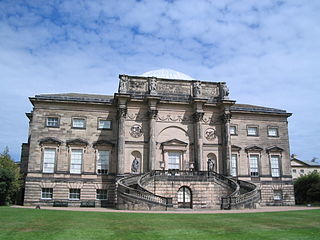
Kedleston Hall is a neo-classical manor house, and seat of the Curzon family, located in Kedleston, Derbyshire, approximately 4 miles (6 km) north-west of Derby. The medieval village of Kedleston was moved in 1759 by Nathaniel Curzon to make way for the manor. All that remains of the original village is the 12th century All Saints Church, Kedleston. Members of the family have held 14 hereditary titles such as: Marquess Curzon of Kedleston, Earl Howe, Earl Curzon of Kedleston, Viscount Curzon, Viscount Scarsdale, Viscounts Howe, Curzon of Kedleston, Baron Scarsdale, Baron Ravensdale, Lord of the Manor of Curzon, Baron Howe, Baron Curzon, Baronet Mosley, and Baronet of Kedleston Hall.

Viscount Scarsdale, of Scarsdale in Derbyshire, is a title in the Peerage of the United Kingdom. It was created in 1911 for the prominent Conservative politician and former Viceroy of India George Curzon, 1st Baron Curzon of Kedleston, who was created Earl Curzon of Kedleston at the same time and was later made Marquess Curzon of Kedleston.

Duke of Dorset was a title in the Peerage of Great Britain. It was created in 1720 for the politician Lionel Sackville, 7th Earl of Dorset.

Edingale is a village and civil parish in Lichfield District, Staffordshire, England. It lies on the River Mease, around 7 miles (11 km) north of Tamworth. Historically, the village is shared with Derbyshire. In 2001 the parish had a population of 598, increasing to 632 at the 2011 census.

Whittington is a village and civil parish which lies approximately 3 miles south east of Lichfield, in the Lichfield district of Staffordshire, England. According to the 2001 census it had a population of 2,591, increasing to 2,603 at the 2011 Census. The parish council is a joint one with Fisherwick. The Coventry Canal borders the village to the north and east.

Prinsep may mean any of several notable members of the British Prinsep family.
Robert I de Ferrers, 1st Earl of Derby was born in Derbyshire, England, a younger son of Henry de Ferrières and his wife Bertha. His father, born in Ferrières, Normandy, France accompanied William the Conqueror during his invasion of England. The family was rewarded with a grant of Tutbury Castle in Staffordshire and 114 manors in Derbyshire.

Kedleston is a village and civil parish in the Amber Valley district of Derbyshire, approximately 4 miles (6.4 km) north-west of Derby. Nearby places include Quarndon, Weston Underwood, Mugginton and Kirk Langley. The population at the 2011 Census was less than 100. Details are included in the civil parish of Mackworth, Amber Valley.
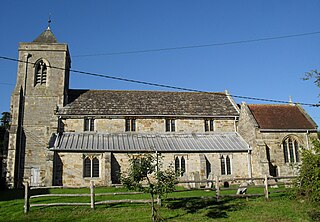
Framfield is a village and civil parish in the Wealden District of East Sussex, England. The village is located two miles (3 km) east of Uckfield; the settlements of Blackboys, Palehouse and Halland form part of the parish area of 6,700 acres (2,706 ha).
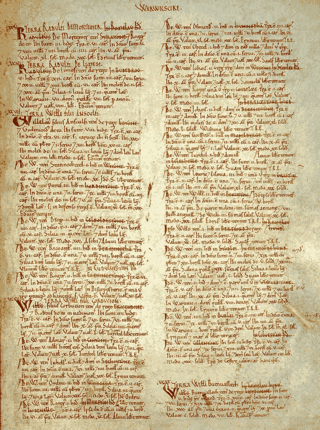
Henry de Ferrers, magnate and administrator, was a Norman who after the 1066 Norman conquest was awarded extensive lands in England.
David Monro was a seigneur, businessman and political figure in Lower Canada. His surname was also sometimes spelled Munro.

Richard Sackville, 5th Earl of Dorset was an English peer and politician.

Levett is a surname of Anglo-Norman origin, deriving from [de] Livet, which is held particularly by families and individuals resident in England and British Commonwealth territories.

Nathaniel Curzon, 2nd Baron Scarsdale was an English Tory politician and peer.

Rev. Thomas Levett served as rector of Whittington, Staffordshire, for 40 years, and as a large landowner in addition to being a clergyman, played a role in the development of Staffordshire's educational system. He was also a member of one of Staffordshire's longest-serving families in ecclesiastical circles, having produced three rectors of the parish of Whittington. The Levett family also produced members of parliament, High Sheriffs of Staffordshire, Lichfield town recorders and businessmen who were friends and contemporaries of Samuel Johnson, Erasmus Darwin, writer Anna Seward, actor David Garrick and other local luminaries. Several streets in Lichfield are named for the family.
Thomas Levett-Prinsep was an English landowner in Derbyshire and Staffordshire. He took on the additional name of Prinsep on inheriting his uncle's holding of Croxall Hall.
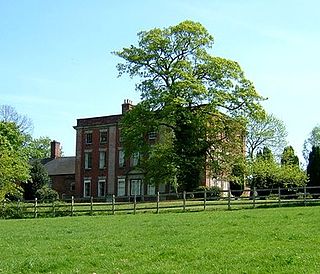
Walton Hall is an 18th-century country house situated in the village of Walton on Trent, Derbyshire. It is a Grade II* listed building but is in slow decay and is officially registered on the Buildings At Risk Register.

Croxall is a hamlet and former civil parish, now in the parish of Edingale, in the Lichfield district, in the county of Staffordshire, England. The settlement today is mainly the Church of England parish church of St John and Croxall Hall. On 30 September 1895 the part in Derbyshire was transferred to Staffordshire meaning Croxall was entirely in Staffordshire. In 1931 the parish had a population of 184.
Sir Thomas Marchington was an English MP for Derbyshire.
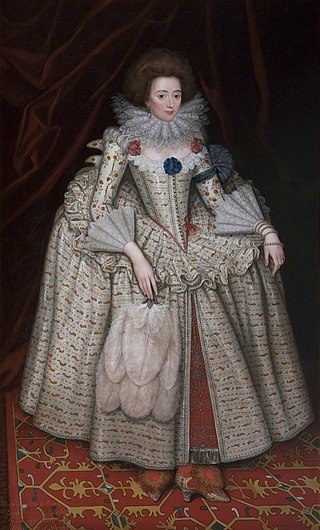
Mary Sackville, Countess of Dorset was an English royal governess.


















